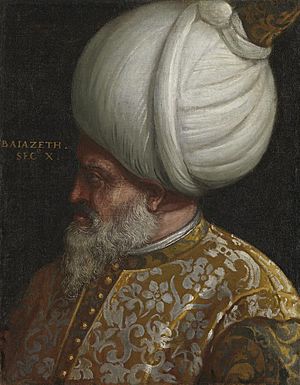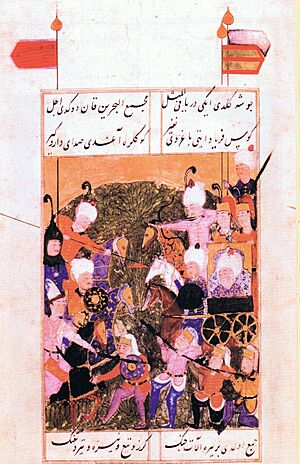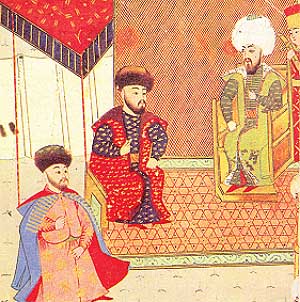Bayezid II facts for kids
Quick facts for kids Bayezid II |
|||||
|---|---|---|---|---|---|
| Kayser-i Rûm | |||||

Bayezid II by Paolo Veronese, c. 16th century
|
|||||
| Sultan of the Ottoman Empire (Padishah) |
|||||
| Reign | 22 May 1481 – 24 April 1512 | ||||
| Predecessor | Mehmed II | ||||
| Successor | Selim I | ||||
| Born | 3 December 1447 Demotika, Ottoman Sultanate |
||||
| Died | 26 May 1512 (aged 64) Abalar, Havsa, Ottoman Empire |
||||
| Burial | Bayezid II Mosque, Istanbul, Turkey | ||||
| Consorts | Şirin Hatun Hüsnüşah Hatun Bülbül Hatun Nigar Hatun Gülruh Hatun Gülbahar Hatun Muhtereme Ferahşad Hatun Others |
||||
| Issue | Şehzade Ahmed Şehzade Korkud Selim I Others |
||||
|
|||||
| Dynasty | Ottoman | ||||
| Father | Mehmed II | ||||
| Mother | Gülbahar Hatun | ||||
| Religion | Sunni Islam | ||||
| Tughra |  |
||||
Bayezid II (born 3 December 1447 – died 26 May 1512) was an important sultan of the Ottoman Empire. He ruled from 1481 to 1512. During his time as sultan, Bayezid made the Ottoman Empire stronger. He also stopped a big rebellion and later gave up his throne to his son, Selim I. Bayezid is also known for helping Sephardi Jews who were forced to leave Spain. He welcomed them into Ottoman lands, especially in Salonica.
Contents
Early Life of Bayezid II
Bayezid II was the son of Mehmed II, a famous Ottoman Sultan. His mother was Gülbahar Hatun, who was from Albania. Bayezid was born in a place called Demotika. He grew up and was educated in Amasya. Later, he served there as a local governor for 27 years. In 1473, he even fought in a battle against another group called the Aq Qoyunlu.
Struggle for the Throne
One of Bayezid II's biggest challenges was his conflict with his younger half-brother, Cem Sultan. Cem also wanted to be sultan. He even got military help from the Mamluks in Egypt.
After their father, Sultan Mehmed II, died, Bayezid was invited to become the new sultan. Cem's armies fought against Bayezid's but were defeated. Cem then sought safety with the Knights Hospitaller on the island of Rhodes. These Knights later handed Cem over to Pope Innocent VIII. The Pope hoped to use Cem to fight against the Ottomans in Europe. However, this plan did not work out, and Cem died in Naples.
Bayezid II's Reign as Sultan
Bayezid II became the Ottoman Sultan in 1481. Like his father, he supported both Western and Eastern cultures. He worked hard to make sure his country ran smoothly. Because of this, people called him "the Just."
During his rule, Bayezid II led many campaigns. He wanted to conquer Venetian lands in Morea. He believed this region was key to the Ottoman Empire's power at sea. In 1497, he went to war with Poland. He won a big victory against the Polish army during the Moldavian campaign. The last of these wars ended in 1501. Bayezid II gained control of the entire Peloponnese region.
His reign also faced challenges from rebellions in the east. Groups like the Qizilbash caused trouble. They were often supported by the shah of Persia, Ismail I. Ismail I wanted to spread Shi'ism to weaken the Ottoman government. At one point, Bayezid II's top advisor, Hadım Ali Pasha, was killed fighting against the Şahkulu rebellion.
Welcoming Jewish and Muslim Immigrants
In 1492, the new country of Spain forced its Jewish and Muslim people to leave. This happened during the Spanish Inquisition. Sultan Bayezid II sent the Ottoman Navy to Spain. His admiral, Kemal Reis, helped evacuate these people safely.
Bayezid sent out messages across his empire. He ordered that these refugees should be welcomed. He allowed them to settle in the Ottoman Empire and become citizens. He even made fun of the Spanish rulers, saying they had made their own country poorer while enriching his. Bayezid threatened anyone who treated the Jewish people badly or refused them entry. Many Jewish scholars and artists came to the Ottoman Empire. They helped the empire grow stronger with new ideas and skills. The first printing press in Constantinople was set up by Sephardic Jews in 1493.
Succession and Final Years

In Bayezid II's later years, a big earthquake hit Constantinople in 1509. After this, a fight for the throne started between his sons, Selim and Ahmet. Ahmet tried to march to Constantinople to take the throne. Selim also started a revolt but was defeated by Bayezid. Selim had to flee to the Crimean peninsula.
Bayezid II worried that Ahmet might try to kill him for the throne. So, he did not let Ahmet enter Constantinople. Selim returned from Crimea. With the support of the Janissaries (elite soldiers), Selim forced his father to give up the throne on 25 April 1512.
Bayezid planned to retire to his hometown of Dimetoka. However, he died on 26 May 1512, just a month after giving up his throne. He was buried next to the Bayezid Mosque in Istanbul.
Bayezid II's Legacy

Sultan Bayezid II ordered his librarian to create a list of all the books in the Topkapı Palace library. This library had a wide variety of books. It showed how open the Ottoman Empire was to different ideas and knowledge from around the world.
Images for kids
See also
 In Spanish: Bayezid II para niños
In Spanish: Bayezid II para niños
- Ottoman–Mamluk War (1485–1491)
- Polish–Ottoman War (1485–1503)




